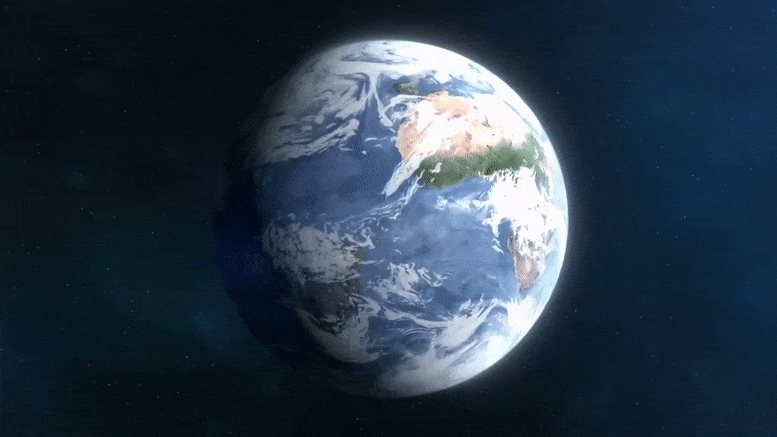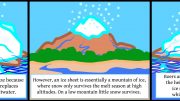
A new study uses the theory of punctuated equilibrium to analyze the hierarchy of climate tipping points, identifying two major events in the last 66 million years that have set the stage for Earth’s current and future climate. The researchers warn that if anthropogenic climate change leads to complete deglaciation, it would be a landmark tipping point affecting Earth’s climate on a geological timescale.
Over the past 66 million years, two major climate events have shaped the climate system, dividing the period into two distinct climate eras.
An analysis of the hierarchy of tipping points indicates that over the past 66 million years, two significant occurrences laid the foundation for subsequent climate tipping and, specifically, the evolution of the climate system. The authors propose that if the current anthropogenic climate change results in total deglaciation, it will impact the development of Earth’s climate on a geological timescale.
The research, conducted by Denis-Didier Rousseau from Université Montpellier, France, Witold Bagniewski from Ecole Normale Supérieure, Paris, France, and Valerio Lucarini from the University of Reading, UK, was published in the journal Scientific Reports and is part of the European TiPES project on tipping points in the Earth System.
Inspired by a theory of evolution
The new insight into the history of climate change was inspired by the theory of punctuated equilibrium which ranks evolutionary changes into hierarchies.
The idea was introduced in the 70’s by Eldredge and Gould as an alternative to classic evolution theory. Punctuated equilibrium proposes that some evolutionary changes determine the evolution of a species more than others. And it explains why species have a tendency to adapt in short evolutionary spurts, rather than gradually over time.

A brief overview of the findings. Credit: TiPES/HP
Rousseau et al. speculated that a similar approach of ranking the importance of historical climate changes through tipping events might prove equally beneficial. For that, they applied advanced statistical methods to two series of climate data with clear signs of critical transitions.
The results indeed suggest that the idea of hierarchies in the evolution of the climate system can lead to new insights. The analysis reveals that two major events out of the ten dominated the evolution of the Earth’s climate system over the last 66 million years.
A hierarchy of climate tipping events
The first event was the Chicxulub meteor impact in Mexico which killed off the large dinosaurs approximately 65,5 million years ago. This catastrophe marked the beginning of a very warm period with high levels of CO2. For the following 30 million years this regime dictated which climatic changes were possible and kept it within the regime of hot and warm climates.
The second crucial event was the tipping point associated with the glaciation of the Southern hemisphere 34 million years ago when the Antarctic continent was isolated at the South Pole due to plate tectonics. The forming of the large ice sheet led to the glaciation of the North as well and marked the beginning of a considerably colder type of climate on Earth, again dictating the scope of future climate changes.
The analysis additionally suggests that our current global climate system still belongs to the latter climate regime and still depends on the existence of the gigantic ice bodies built within the Coolhouse/Icehouse era.
Serious repercussions
In the event that the ice sheets should not withstand anthropogenic global warming, the deglaciation will therefore represent a landmark tipping point similar to the two that have dominated Earth’s history leading to a new unknown climate landscape.
”The ice sheets are key components in the present climate system. But they are very sensitive. They presently experience a negative mass balance, and there are numerous reports of evidence of melting under the impact of the current climate warming, translating a trend towards a potential tipping point that could accelerate the disappearance at least of Greenland and West Antarctica, with serious repercussions for our societies” says Denis-Didier Rousseau.
“Crossing tipping points has been a recurrent feature in climate evolution. Our study reveals a better understanding of the mathematics of such events. As a consequence, strategies of adaptation to and mitigation of climate change should now take into account the possible destabilization of tipping elements,” adds Valerio Lucarini.
Reference: “A punctuated equilibrium analysis of the climate evolution of cenozoic exhibits a hierarchy of abrupt transitions” by Denis-Didier Rousseau, Witold Bagniewski and Valerio Lucarini, 12 July 2023, Scientific Reports.
DOI: 10.1038/s41598-023-38454-6
The TiPES project is an EU Horizon 2020 interdisciplinary climate science project on tipping points in the Earth system. 18 partner institutions work together in more than 10 countries. TiPES is coordinated and led by The Niels Bohr Institute at the University of Copenhagen, Denmark, and the Potsdam Institute for Climate Impact Research, Germany. The TiPES project has received funding from the European Horizon 2020 research and innovation program, grant agreement number 820970.








The authors use a non-rigorous use of the term Tipping Point. Perhaps that is why they don’t formally define it! A Tipping Point implies something from which a dynamic system cannot recover, such as Earth being engulfed by the Red Giant our sun almost certainly will become in the future, or the loss of oxygen and water from Mars.
This is a curious classification of climate. First off, it is surprising that the Great Oxygenation Event in the Precambrian wasn’t mentioned. It was truly a Tipping Point from which the Earth has not ‘recovered,’ and hopefully, never will.
It is strange that the role of plate tectonics, specifically the breakup of Gondwanaland and Pangaea, and numerous orogenies, is not acknowledged (With the exception of Antarctica being ‘orphaned.’). It should be obvious that a particular continental climate that is the result of a significant mountain range, may be emulated by a re-animated orogeny; however, it will not be exactly the same, nor follow the same trajectory. Therefore, calling the specific climates the result of Tipping Points created by orogenies is probably justified. However, they are not mentioned! Mountain ranges, particularly those with with their spines stretched in the direction of the poles, interrupt the prevailing winds and introduce turbulence, induce precipitation by orographic uplift, and change rain to snow when the mountains get tall enough. The process is reversed as the mountain range(s) is/are reduced by erosion, eventually resulting in a warm, wet peneplane. In either case, a rain shadow (hot and dry) can be expected on the leeward side of the chain, which varies in extent and severity with the height of the range.
It has been suggested that the closing of the Panama isthmus was responsible for glaciation of the Pleistocene through the severing of important ocean currents transporting warm tropical waters pole ward.
Plate tectonics has been an accepted paradigm for 50 years. Yet, these authors write as though it is inconsequential with respect to climate, mentioning it only in association with the isolation of the Antarctic plate. I think that they are too anxious to assign the dominant influence on warming to anthropogenic CO2, and consequently overlook the other obvious contributors. Whether it is the result of unconscious bias, or an insufficient grasp of geology, their peers need to challenge the unstated assumptions that lead to their conclusions.
“…, The forming of the large ice sheet led to the glaciation of the North as well and marked the beginning of a considerably colder type of climate on Earth, …”
I guess they have not heard of the the Milankovitch Cycles either.
I’m interested
“The second crucial event was the tipping point associated with the glaciation of the Southern hemisphere 34 million years ago when the Antarctic continent was isolated at the South Pole due to plate tectonics.”
That coincides with the beginning of the Oligocene Epoch, which was a time of extensive global vulcanism. Was the SH glaciation a result of the detachment of the Antarctic plate over the South Pole, or the extensive vulcanism reducing surface insolation? The one time the authors give recognition to Plate tectonics, they overlook something that was probably more important.